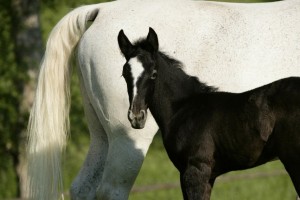…And the White Horse You Rode in On: Genetics Research Unravels White Horse Code, Finds Suprises
- March 10, 2017
- ⎯ Fran Jurga

This Lipizzaner foal at the Spanish Riding School’s breeding farm in Piber, Austria, will soon start turning gray; he will eventually be almost white. As gray horses mature, their chances of developing melanoma, a form of skin cancer, can be as high as 75 percent. Swedish researchers found that gene regulation problems are common to all white horses and that they are all descended from a single, original white horse.
Sunday morning means reading as many newspapers as possible around here. It doesn’t mean reading scientific journals, but when the Sunday papers are quoting the journal Nature Genetics for a study about horses, the keyboard goes back into action, especially when it had me thinking about equine icons.
Silver. Thunderhead. The Lippizaner stallions of the Spanish Riding School. Hirohito’s white stallion. Desert Orchid. Milton. Abdullah. Snowman. Napoleon’s Marengo. The list goes on and on. And let’s not forget those white chalk horses cut into those British hillsides by the ancient horse worshippers. And that white horse your knight in shining armor is sure to be riding.
White horses are a symbol of something, we’ve never been quite sure what. Are they truly superior or just eyecatching? Is it saying something about the horse itself or is it what they say about the person riding them? Could Buffalo Bill Cody have ridden anything but a white horse??
But if you have ever owned a white or “gray” horse, you may well know the worries of melanoma, a type of skin cancer that has become so common that about 75 percent of gray horses older than 15 years of age have a benign form of melanoma that in some cases develops into a malignant melanoma.
An international team led by researcher Leif Andersson, shown at left, at Uppsala University has now identified the mutation causing this spectacular trait and show that white horses carry an identical mutation that can be traced back to a common ancestor that lived thousands of years ago. The study is interesting for medical research since this mutation also enhances the risk for melanoma.

Here’s some background: A “gray” horse is born dark (black, brown or chestnut) but the graying process starts as soon as the foal’s first year and they are normally completely white by six to eight years of age. However, the skin remains pigmented. Thus, the process resembles graying in humans but the process is ultrafast in these horses. The research presented now demonstrates that all gray (white) horses carry exactly the same mutation which must have been inherited from a common ancestor that lived thousands of years ago.
That makes the Thoroughbred breed–descended from three Arabian stallions–look quite diverse, in comparison.
The study reported today has also given new insight in a molecular pathway that may lead to tumor development. Andersson and his team propose that the gray mutation stimulates growth of melanocytes and that this leads to a premature loss of the melanocyte stem cells needed for hair pigmentation whereas the mutation promotes an expansion of some of the melanocytes causing skin pigmentation. The gray mutation does not change any protein structure but it affects the genetic regulation of two genes.
(To oversimplify: the mutation causes two reactions, one in the skin and one in the coat. The key cells needed to color the hair are lost, while the key cells that color the skin multiply.)
The researchers found that the white horses carry an extra copy of a DNA segment located in one of these genes.
“It is very likely that regulatory mutations like the one we found in these white horses constitute the dominating class of mutations explaining differences between breeds of domestic animals,” concludes Leif Andersson.
Now, that’s news.





